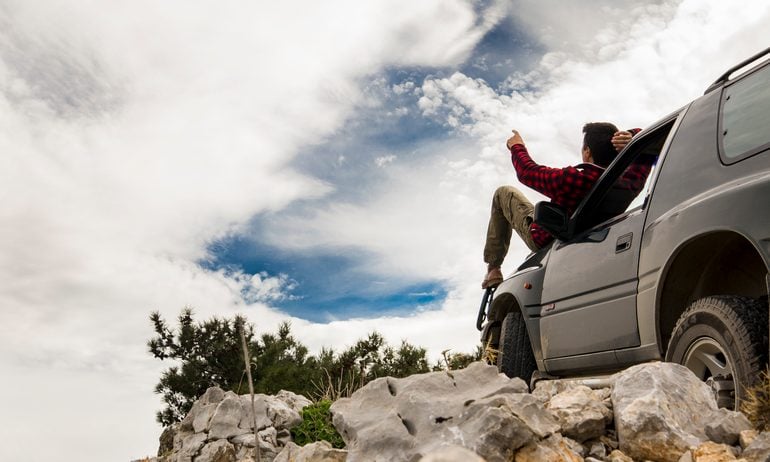Choose the Right Vehicle for Your Off-Road Adventures
A versatile SUV can take you almost anywhere, but prepare for trade-offs the farther you venture off-road.

Many, or all, of the products featured on this page are from our advertising partners who compensate us when you take certain actions on our website or click to take an action on their website. However, this does not influence our evaluations. Our opinions are our own. Here is a list of our partners and here's how we make money.
If you’re looking for an exciting way to practice social distancing, buy an off-road vehicle and explore the great outdoors. But first, make sure you choose an SUV or truck that can handle the level of adventure you’re seeking.
When you go off the grid, “you know there will be obstacles, but you don’t exactly know what they’ll be,” says Dan Edmunds, an Autoblog contributor with an off-roading YouTube channel under his own name.
Someone wandering back roads doesn’t need (and may even want to avoid) the equipment needed to ford deep streams or go rock-hopping.
Josh Sadlier, director of content strategies for car site Edmunds.com, needed a vehicle that could not only handle mountain jeep trails but could also accommodate a baby seat for his 6-month-old daughter. He’s happy with the 2000 Toyota Land Cruiser he recently bought and has already logged 9,000 miles exploring the backcountry of California, often with his wife and daughter aboard.
Here are the three levels of off-roading and the options experts say you’ll need to handle the terrain.
Explore the auto-buying platforms from our partners below.
AD
Level 1: Dirt road exploring
Maybe you like wandering down fire service roads or you’re a mountain biker who needs to climb a dirt road to get to the trailhead. You’ll want a vehicle with higher ground clearance to drive over unmaintained roads with a high center crown or safely navigate occasional rocky stretches.
Many stock SUVs and crossovers, with two-wheel drive, could probably handle most dirt roads. But to be on the safe side, Dan Edmunds recommends opting for all-wheel drive so you’ll have better traction for unexpectedly steep climbs or slippery conditions.
Level 2: Overlanding
This is when you drive to remote locations and need to haul enough gear to spend a few days in the wilderness. “Maybe you want to drive to a ghost town or abandoned mine and spend several days where there’s no cell phone service,” Edmunds says.
For this, Edmunds recommends a vehicle with four-wheel drive including low range to climb steep grades and plow through loose dirt and rock. Also, you might need stronger shock absorbers to handle the increased weight.
Level 3: Rock crawling
In this most extreme form of off-roading, the objective is to find the worst conditions possible and challenge yourself as a driver, Edmunds says. Often, rock crawlers will have people acting as spotters outside the vehicle guiding the driver from one boulder to another.
To handle these conditions, four-wheel drive with low range and higher ground clearance is a must. Also, you'll want a locking rear differential to further increase traction in snow, mud and loose gravel.
And if the vehicle gets stuck, a front-mounted winch can be connected to a nearby tree or another vehicle to pull it out of trouble.

See what you could save on car insurance
Easily compare personalized rates to see how much switching car insurance could save you.Searching for an off-roader
Although manufacturers sell cars pre-built for off-roading, many people like to buy a used vehicle and add the modifications — bigger tires, stronger shock absorbers and “lift kits” — themselves. “It’s the new hot-rodding,” Edmunds says.
You can spend as little as $200 a tire on all-terrain tires to prevent punctures from sharp rocks. But the big wheel and tire combinations needed for rock crawling, mud or sand dunes can cost thousands.
Dependability was No. 1 on Sadlier’s list when he shopped for an off-road vehicle. Reading automotive forums, he learned that the V-8 engine in the Toyota Land Cruiser was legendary. “If you’re miles from nowhere, with no cell phone service, you want to know your car will always start.”
Automotive classified sites such as Craigslist and Autotrader are useful for locating hard-to-find vehicles. “Cast a wide net,” says Sadlier, who spent weeks searching for a Land Cruiser. Finally, he located one in the San Francisco area with only 94,000 miles and quickly snapped it up for $16,000. He bought bigger all-terrain tires, removed the running boards and grill guards, then headed for the great outdoors.
“I love seeing a dirt side road, wondering where it goes and just turning off and exploring,” he says.
Before you write a check
Experts offer the following advice when shopping for an off-road vehicle:
Read off-roading forums to learn which vehicles can handle the conditions you plan to encounter. Watch YouTube videos to see the capabilities of those vehicles you’re considering.
Buying a used vehicle with modifications can actually save money since the cost of the added equipment isn’t included in pricing guides.
Make sure options added to a used vehicle are from a reputable manufacturer and were properly installed.
As with any used car purchase, always get a vehicle history report and take the vehicle to a mechanic for an inspection (although you’ll have to pay for this service).
Test-driving a vehicle in off-road conditions is usually not an option. But at least drive over rough pavement or railroad tracks to see how the suspension performs.
Automatic transmissions can easily handle off-road conditions and make driving around town less of a chore than shifting a manual transmission.
You may need to add riders to your insurance to make sure any equipment or modifications you add are covered for theft or damage.




